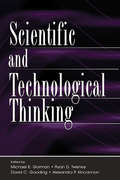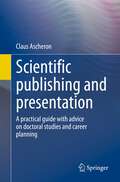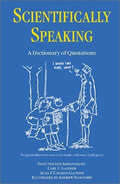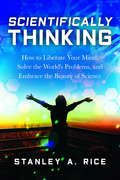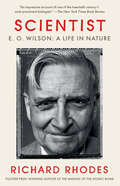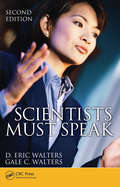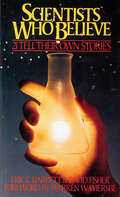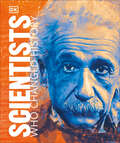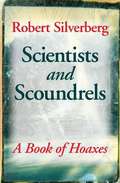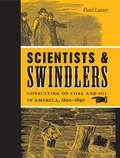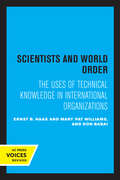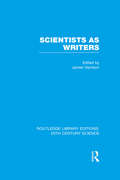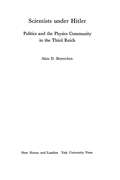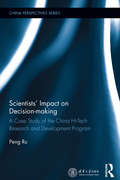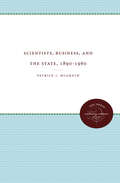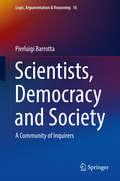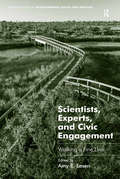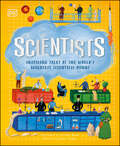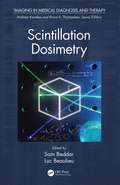- Table View
- List View
Scientific and Technological Thinking
by Michael E. Gorman Ryan D. Tweney David C. Gooding Alexandra P. KincannonAt the turn of the 21st century, the most valuable commodity in society is knowledge--particularly new knowledge that may give a culture, company, or laboratory an adaptive advantage. Knowledge about the cognitive processes that lead to discovery and invention can enhance the probability of making valuable new discoveries and inventions. Such knowledge needs to be made widely available to ensure that no particular interest group "corners the market" on techno-scientific creativity. Knowledge can also facilitate the development of business strategies and social policies based on a genuine understanding of the creative process. Furthermore, through an understanding of principles underlying the cognitive processes related to discovery, educators can utilize these principles to teach students effective problem-solving strategies as part of their education as future scientists.This book takes the reader out onto the cutting edge of research in scientific and technological thinking. The editors advocate a multiple-method approach; chapters include detailed case studies of contemporary and historical practices, experiments, computational simulations, and innovative theoretical analyses. The editors attempt a provocative synthesis of this work at the end.In order to achieve true scientific and technological progress, an understanding of the process by which species are transforming the world is needed. This book makes an important step in that direction by leading to breakthroughs in the understanding of discovery and invention.
Scientific publishing and presentation: A practical guide with advice on doctoral studies and career planning
by Claus AscheronThe aim of this book is to help young scientists improve their oral and written communication skills and thus better sell their own results. This book is not a scientific textbook. It addresses the often forgotten question of how to present one's scientific results effectively and convincingly in talks and publications. In addition, this book provides background knowledge on the process of scientific publishing and scientific customs. The recommendations help to develop a good and effective work and communication style that will benefit you throughout your life and bring satisfaction in your work. Furthermore, concrete advice is given on how to write and successfully defend a dissertation and how to take the first steps in career planning.
Scientifically Speaking: A Dictionary of Quotations, Second Edition
by C.C. Gaither Alma E Cavazos-GaitherIn these days of ever-increasing specialization, it is important to gain a broad appreciation of science. Entertaining and informative, Scientifically Speaking: A Dictionary of Quotations, Second Edition contains the words and wisdom of several hundred scientists, writers, philosophers, poets, and academics. The largest compilation of published sci
Scientifically Thinking: How to Liberate Your Mind, Solve the World's Problems, and Embrace the Beauty of Science
by Stanley A. RiceShows the many advantages of thinking like a scientist and argues that today's problems require a scientific approach.You don't have to be a scientist to think like a scientist. Anyone can do it and everyone should. This book will show you how. The advantages are many: from detecting bias to avoiding error and appreciating the richness of the world. Author Stanley Rice, himself a scientist, explains that science is essentially organized common sense. While the brain is hardwired for common sense, unfortunately, it also relies on a number of misleading tendencies. Instead of reasoning objectively it tends to rationalize. Often it sees what it wants to see rather than what is really there. And it is adept at both self-deception and deceiving others. Rice notes that these tendencies were useful in the past as the human race evolved in an often-hostile environment. But today bias and delusions put us at risk of worldwide catastrophe.The author invites readers to participate in the adventure of scientific discovery. He provides many interesting and humorous examples of how science works. He shows how hypothesis testing can be used to tackle everyday problems like car trouble or seeing through the specious appeal of a fad diet. Beyond practical applications, science meets the basic human need to satisfy curiosity: it tells verifiable stories about the universe, providing humans with fascinating narratives supported by testable facts. The author also explores some of science's biggest ideas, including natural selection (creating order out of randomness) and interconnectedness (Earth's systems are intricately intertwined). Read this book and learn to think like a scientist. It will guard you against being manipulated by politicians, corporations, and religious leaders, and equip you to deal with the world's most pressing problems. And you will have a lot of fun doing it.
Scientist, Scientist, Who Do You See?
by Chris Ferrie<p>A scientific twist on a beloved children's classic that's sure to delight both parent and child! <p>Scientist, Scientist, Who do you see? I see Marie Curie in her laboratory! <p>The adored children's classic Brown Bear, Brown Bear gets a nerdy makeover in this picture book by the #1 bestselling science author for kids! Young readers will delight at taking a familiar text and poking fun at it all while learning about scientists and how they changed the world. Back matter includes brief biographical information of the featured scientists. This sweet parody is the perfect inspiration for scientists of all ages! <p>Full of scientific rhyming fun, Scientist, Scientist, Who Do You See? features appearances by some of the world's greatest scientists! From Albert Einstein to Marie Curie and Ahmed Zewail, from Charles Darwin to Chien-Shiung Wu and Grace Hopper... and more!</p>
Scientist: E. O. Wilson: A Life in Nature
by Richard RhodesA masterful, timely, fully authorized biography of the great and hugely influential biologist and naturalist E. O. Wilson, one of the most ground-breaking and controversial scientists of our time—from the Pulitzer Prize-winning author of The Making of the Atomic Bomb &“An impressive account of one of the 20th century&’s most prominent biologists, for whom the natural world is &‘a sanctuary and a realm of boundless adventure; the fewer the people in it, the better.&’&” —The New York Times Book ReviewFew biologists in the long history of that science have been as productive, as ground-breaking and as controversial as the Alabama-born Edward Osborne Wilson. At 91 years of age he may be the most eminent American scientist in any field.Fascinated from an early age by the natural world in general and ants in particular, his field work on them and on all social insects has vastly expanded our knowledge of their many species and fascinating ways of being. This work led to his 1975 book Sociobiology, which created an intellectual firestorm from his contention that all animal behavior, including that of humans, is governed by the laws of evolution and genetics. Subsequently Wilson has become a leading voice on the crucial importance to all life of biodiversity and has worked tirelessly to synthesize the fields of science and the humanities in a fruitful way.Richard Rhodes is himself a towering figure in the field of science writing and he has had complete and unfettered access to Wilson, his associates, and his papers in writing this book. The result is one of the most accomplished and anticipated and urgently needed scientific biographies in years.
Scientists Ask Questions (Fountas & Pinnell LLI Blue #Level K)
by Ginger GarrettA simple introduction to scientific investigation, describing what it is and giving examples of how scientists use tools and conduct experiments.
Scientists Making a Difference
by Robert J. Sternberg Susan T. Fiske Sternberg, Robert J. and Fiske, Susan T. and Foss, Donald J. Donald J. FossScientists Making a Difference is a fascinating collection of first-person narratives from the top psychological scientists of the modern era. These readable essays highlight the most important contributions to theory and research in psychological science, show how the greatest psychological scientists formulate and think about their work, and illustrate how their ideas develop over time. In particular, the authors address what they consider their most important scientific contribution, how they got the idea, how the idea matters for the world beyond academic psychology, and what they would like to see as the next steps in research. The contributors, who were chosen from an objectively compiled list of the most eminent psychological scientists, provide a broad range of insightful perspectives. This book is essential reading for students, researchers and professionals interested in learning about the development of the biggest ideas in modern psychological science, described firsthand by the scientists themselves.
Scientists Must Speak
by D. Eric Walters Gale C. WaltersHaving the ability to speak confidently; engage the audience; make a clear, well-argued case; and handle any tricky situations, is rarely a natural talent, but it can be learned through application and practice. Scientists Must Speak, Second Edition, helps readers do just that.At some point in their careers, the majority of scientists have to stand
Scientists Who Believe: 21 Tell Their Own Stories
by David Fisher Eric C. BarrettHere are the stories of scientists, both men and women, who have achieved career fulfillment in the sciences, yet found further fulfillment through faith in Jesus Christ.
Scientists Who Believe: 21 Tell Their Own Stories
by David Fisher Eric C. BarrettHere are the stories of scientists, both men and women, who have achieved career fulfillment in the sciences, yet found further fulfillment through faith in Jesus Christ.
Scientists Who Changed History (DK People Who Changed History)
by DKExplore the lives and achievements of more than 85 of the world's most inspirational and influential scientists with this innovative and boldly graphic biography-led book.The second title in DK's new illustrated biography series, Scientists Who Changed History profiles trailblazing individuals from Greek mathematicians, such as Archimedes and Hipparchus, through physicists of the early 20th-century, such as Marie Curie and Albert Einstein, to modern greats such as Stephen Hawking and Tim Berners-Lee. Each featured individual has made a major contribution to one or more scientific fields, from astronomy, biology, and psychology, to computer science and geology.Combining elements of biography, history, and analysis, Scientists Who Changed History explains the groundbreaking contributions made by these revolutionary men and women in a clear and informative way.
Scientists and Scoundrels: A Book of Hoaxes
by Robert SilverbergAs if history and nature had not provided wonders enough, through the ages humans themselves have contrived more marvels to deceive one another. Sometimes they have concocted evidence when none was available to prove pet theories; sometimes their intention has been to impress or defraud; sometimes they have acted merely for sport. Robert Silverberg tells the stories of a baker's dozen of these scientific hoaxers in a lively, good-humored book that ranges through time and across continents. Here are perpetual-motion machines and space rockets, men on the moon and serpents in the sea. The rogues' gallery is a varied one: Dr. Mesmer, who cast his hypnotic spell on eighteenth-century Paris; Charles Dawson, whose Piltdown Man challenged evolution; Dr. Cook, with his tale of "discovering" the North Pole; and many others. These are fascinating stories and more than just entertainment. The author explains the scientific background against which the hoaxes appeared and the detective work that led to their exposure. The schemers teach us to be alert, to challenge the evidence, and to appreciate the healthy skepticism that characterizes the scientific method.
Scientists and Swindlers: Consulting on Coal and Oil in America, 1820–1890 (Johns Hopkins Studies in the History of Technology)
by Paul LucierIn this impressively researched and highly original work, Paul Lucier explains how science became an integral part of American technology and industry in the nineteenth century. Scientists and Swindlers introduces us to a new service of professionals: the consulting scientists. Lucier follows these entrepreneurial men of science on their wide-ranging commercial engagements from the shores of Nova Scotia to the coast of California and shows how their innovative work fueled the rapid growth of the American coal and oil industries and the rise of American geology and chemistry. Along the way, he explores the decisive battles over expertise and authority, the high-stakes court cases over patenting research, the intriguing and often humorous exploits of swindlers, and the profound ethical challenges of doing science for money.Starting with the small surveying businesses of the 1830s and reaching to the origins of applied science in the 1880s, Lucier recounts the complex and curious relations that evolved as geologists, chemists, capitalists, and politicians worked to establish scientific research as a legitimate, regularly compensated, and respected enterprise. This sweeping narrative enriches our understanding of how the rocks beneath our feet became invaluable resources for science, technology, and industry.
Scientists and Swindlers: Consulting on Coal and Oil in America, 1820–1890 (Johns Hopkins Studies in the History of Technology)
by Paul LucierAn “insightful” account of the early fossil fuel industry, the rise of the professional consultant, and the nexus between science and money (Technology and Culture).In this impressively researched, highly original work, Paul Lucier explains how science became an integral part of American technology and industry in the nineteenth century. Scientists and Swindlers introduces us to a new service of professionals: the consulting scientists. Lucier follows these entrepreneurial men of science on their wide-ranging commercial engagements from the shores of Nova Scotia to the coast of California and shows how their innovative work fueled the rapid growth of the American coal and oil industries and the rise of American geology and chemistry. Along the way, he explores the decisive battles over expertise and authority, the high-stakes court cases over patenting research, the intriguing and often humorous exploits of swindlers, and the profound ethical challenges of doing science for money. Starting with the small surveying businesses of the 1830s and reaching to the origins of applied science in the 1880s, Lucier recounts the complex and curious relations that evolved as geologists, chemists, capitalists, and politicians worked to establish scientific research as a legitimate, regularly compensated, and respected enterprise. This sweeping narrative enriches our understanding of how the rocks beneath our feet became invaluable resources for science, technology, and industry.
Scientists and World Order: The Uses of Technical Knowledge in International Organizations
by Ernst B. Haas Mary Pat Williams Don BabaiThis title is part of UC Press's Voices Revived program, which commemorates University of California Press’s mission to seek out and cultivate the brightest minds and give them voice, reach, and impact. Drawing on a backlist dating to 1893, Voices Revived makes high-quality, peer-reviewed scholarship accessible once again using print-on-demand technology. This title was originally published in 1977.
Scientists as Writers (Routledge Library Editions: 20th Century Science)
by James HarrisonIn the endless debate about the Two Cultures no book until this attempted to provide a selection of scientific writing on specific themes to stimulate students of arts subjects into discussion and writing about the nature of science and its relationship with the rest of life. This book is based on a selection of prose passages written by scientists about science, supplemented by notes and a brief linking commentary. Originally published in 1965, the passages were chosen to illustrate or comment on different aspects of eleven main themes, ranging from surveys of changing ideas on the nature of the universe and the material of which it was made, to evolution past and future and the relation of science with religion and art. Most of the extracts were from contemporary authors, but there are passages by Aristotle, Bacon, Boyle, Hooke, Newton, Dalton, Faraday and Darwin. At the end of the book there are suggestions for discussion to accompany each chapter, to encourage the study of the use of language in consideration of the nature, history and role of science.
Scientists at War
by Sarah BridgerSarah Bridger examines the ethical debates that tested the U.S. scientific community during the Cold War, and scientists' contributions to military technologies and strategic policymaking, from the dawning atomic age through the Strategic Defense Initiative (Star Wars) in the 1980s, which sparked cross-generational opposition among scientists.
Scientists under Hitler: Politics and the Physics Community in the Third Reich
by Alan D. BeyerchenThe treatment of German physicists under the Nazi regime had far-reaching consequences both for the outcome of the Second World War and for the course of science for decades thereafter. Although this fact has been known from a few famous episodes, it has not been dealt with thoroughly by scholars because it involves two very different disciplines. Political historians have cautiously left it to historians of science, who in turn have shied away from it out of ignorance of the political intricacies. Alan D. Beyerchen here examines this history in detail, basing his research on archival materials in Germany and the United States and on tape-recorded interviews with leading physicists. At least twenty-five percent of Germany's academic physicists who were working in 1933 lost their positions during the Nazi period. The victims -- Jews and other "politically unreliable" persons -- included some of Germany's finest scientists. Those who remained faced opposition not only from Nazi officials but also from certain members of their own community, notably the Nobel laureates Philipp Lenard and Johannes Stark. Beyerchen describes the mechanisms of prejudice, the reaction to the dismissals, and the impact of the "Aryan physics" movement which ultimately failed.
Scientists' Impact on Decision-making: A Case Study of the China Hi-Tech Research and Development Program (China Perspectives)
by Peng RuWith the increasing influence of science and technology (S&T) on socioeconomic life and public affairs, there has been a growing demand for S&T expertise in today's public decision-making. The National High Technology Research and Development Program (863 Program), involving hundreds of S&T experts, marked the beginning of a new journey for China's high-tech development. This book discusses China's S&T decision-making mechanism, with the 863 Program as the central case and scientist' influence on public decision-making as the focus. More importantly, it extracts three key elements to analyze the determinative factors behind that influence — knowledge, value and institutions, and proposed a KIV framework of macro-analysis. The KIV, being the first framework to generalize factors that could affect scientists' influence on public decision-making, is of both theoretical significance and innovative value. In addition, by finding out those factors, this book attempts to create a decision-making environment conducive to scientists' contribution of their knowledge.
Scientists, Business, and the State, 1890-1960 (The Luther H. Hodges Jr. and Luther H. Hodges Sr. Series on Business, Entrepreneurship, and Public Policy)
by Patrick J. McGrathIn the late nineteenth century, scientists began allying themselves with America's corporate, political, and military elites. They did so not just to improve their professional standing and win more money for research, says Patrick McGrath, but for political reasons as well. They wanted to use their new institutional connections to effect a transformation of American political culture. They succeeded, but not in ways that all scientists envisioned or agreed upon. McGrath describes how, between 1890 and 1960, scientific, business, and political leaders together forged a new definition of American democracy in which science and technology were presented to the public as crucial ingredients of the nation's progress, prosperity, and political stability. But as scientists became more prominent, they provoked conflicts among themselves as well as with their institutional patrons over exactly how their expertise should be used. McGrath examines the bitter battles that erupted over the role scientists should play during the Great Depression, World War II, the Cold War arms race, and the security and loyalty investigations of the 1950s. He finds that, by the end of the 1950s, scientists were regarded by the political and military elite not as partners but as subordinate technicians who were expected to supply weapons on demand for the Cold War state.Originally published 2001.A UNC Press Enduring Edition -- UNC Press Enduring Editions use the latest in digital technology to make available again books from our distinguished backlist that were previously out of print. These editions are published unaltered from the original, and are presented in affordable paperback formats, bringing readers both historical and cultural value.
Scientists, Democracy and Society: A Community Of Inquirers (Logic, Argumentation And Reasoning Ser. #16)
by Pierluigi BarrottaThis monograph examines the relationship between science and democracy. The author argues that there is no clear-cut division between science and the rest of society. Rather, scientists and laypeople form a single community of inquiry, which aims at the truth.To defend his theory, the author shows that science and society are both heterogeneous and fragmented. They display variable and shifting alliances between components. He also explains how information flow between science and society is bi-directional through “transactional” processes. In other words, science and society mutually define themselves. The author also explains how science is both objective and laden with values.Coverage includes a wide range of topics, such as: the ideal of value-free science, the is/ought divide, “thick terms” and the language of science, inductive risk, the dichotomy between pure science and applied science, constructivism and the philosophy of risk. It also looks at the concepts of truth and objectivity, the autonomy of science, moral and social inquiry, perfectionism and democracy, and the role of experts in democratic societies. The style is philosophical, but the book features many examples and case-studies. It will appeal to philosophers of science, those in science and technology studies as well as interested general readers.
Scientists, Experts, and Civic Engagement: Walking a Fine Line (Routledge Studies in Environmental Policy and Practice)
by Amy E. LesenHow do scientists, scholars, and other experts engage with the general public and with the communities affected by their work or residing in their sites of study? Where are the fine lines between public scholarship, civic engagement, and activism? Must academics 'give back' once they collect data and publish results? In this volume, authors from a wide range of disciplines examine these relationships to assess how they can be fruitful or challenging. Describing the methodological and ethical issues that experts must consider when carrying out public scholarship, this book includes a checklist for critical factors of success in engagement and an examination of the role of digital social media in science communication. Illustrated by a range of case studies addressing environmental issues (climate change, resource use, post-disaster policy) and education, it offers an investigation into the levels and ways in which scholars can engage, and how and whether academics and experts who engage in community work and public scholarship are acknowledged and rewarded for doing so by their institutions. Also bringing into the debate the perspective of citizens who have collaborated with academics, the book offers an exploration of the democratizing potential of participatory action research.
Scientists: Inspiring Tales of the World's Brightest Scientific Minds (DK Explorers)
by DKMeet the people who changed the world of science and technology, biology, chemistry and physics!Read the stories of the brainiest people who ever lived and the scientific discoveries they made. Each page illustrates a famous scientist's life and what made their contribution to this fascinating field so important. Scientists is an exciting book perfect for children ages 7-9 years. Inside you will find: • Stories of more than 50 scientists like Isaac Newton, both famous and lesser-known. • Comprehensive coverage of the most important scientific advancements of all time. • Stories of scientists from all over the world specializing in different areas of science. • Information inline with the STEAM and STREAM school curriculums. Introduce children to titans of science!The biggest scientific breakthroughs in history have something in common: super smart people who kept looking for the answers to some of the world&’s most interesting questions! The pages of this science book are filled with the stories of famous scientists like physicists Neil DeGrasse Tyson and Stephen Hawking, biologist Marie Curie, paleontologist Mary Anning, and lesser-known trailblazers like Chika Kuroda, who became Japan's first female Bachelor of Science.Filled with great detail and following a storytelling format, this is a thrilling book that will capture the imagination of young children and encourage them to explore the world of science. Beautiful descriptions of the scientists' lives are brought to life through stunning watercolor illustrations, and fantastic photography highlights the detail of their discoveries.Discover more stories!Follow the stories of some of the greatest people the world has ever known. DK&’s Scientist, Explorers, and Inventors captures the genius of people who have changed history, answered important questions and made our lives easier.
Scintillation Dosimetry (Imaging in Medical Diagnosis and Therapy)
by Sam Beddar Luc BeaulieuScintillation Dosimetry delivers a comprehensive introduction to plastic scintillation dosimetry, covering everything from basic radiation dosimetry concepts to plastic scintillating fiber optics. Comprised of chapters authored by leading experts in the medical physics community, the book: Discusses a broad range of technical implementations, from point source dosimetry scaling to 3D-volumetric and 4D-scintillation dosimetry Addresses a wide scope of clinical applications, from machine quality assurance to small-field and in vivo dosimetry Examines related optical techniques, such as optically stimulated luminescence (OSL) or Čerenkov luminescence Thus, Scintillation Dosimetry provides an authoritative reference for detailed, state-of-the-art information on plastic scintillation dosimetry and its use in the field of radiation dosimetry.
